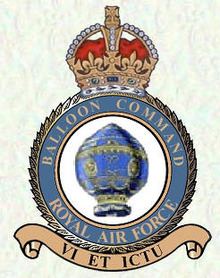Balloon Command was the Royal Air Force command which was responsible for controlling all the United Kingdom-based barrage balloon units during World War II.
Prior to the establishment of Balloon Command, a balloon group was brought into being in 1937. This smaller formation was known as No. 30 (Balloon Barrage) Group and was commanded by Air Commodore John Hearson. Balloon Command itself was formed on 1 November 1938 at RAF Stanmore Park in Middlesex. It consisted of a headquarters and several groups. Balloon Command was disbanded in February 1945.
Commanders
The following officers were in command:
1 November 1938 Air Vice-Marshal Owen Tudor Boyd1 December 1940 Air Marshal Sir Leslie Gossage1 February 1944 Air Vice-Marshal W C C Gell13 February 1945 Air Commodore P L LincolnBefore the second world war the command had one group - No. 30 (Balloon) Group at four stations:
No. 1 Balloon Centre at KidbrookeNo. 901 (County of London) (Balloon) Squadron Auxiliary Air ForceNo. 902 (County of London) (Balloon) Squadron Auxiliary Air ForceNo. 903 (County of London) (Balloon) Squadron Auxiliary Air ForceNo. 2 Balloon Centre at HookNo. 904 (County of Surrey) (Balloon) Squadron Auxiliary Air ForceNo. 905 (County of Surrey) (Balloon) Squadron Auxiliary Air ForceNo. 3 Balloon Centre at StanmoreNo. 906 (County of Middlesex) (Balloon) Squadron Auxiliary Air ForceNo. 907 (County of Middlesex) (Balloon) Squadron Auxiliary Air ForceNo. 4 Balloon Center at ChigwellNo. 908 (County of Essex) (Balloon) Squadron Auxiliary Air ForceNo. 909 (County of Essex) (Balloon) Squadron Auxiliary Air ForceNo. 910 (County of Essex) (Balloon) Squadron Auxiliary Air ForceDuring World War II, the command had the following organization:
Headquarters at Old Church Lane, Stanmore in Middlesex. This in turn directly controlled:RAF CardingtonRAF ChessingtonThe command consisted of five groups which were in turn subdivided into balloon centres (equivalent to wings of heavier-than-air aircraft). The organization was as follows:
No. 30 Group headquartered at Chessington, near Surbiton, Surrey (1 November 1938 to 7 January 1945)No. 1 Balloon CentreNo. 2 Balloon CentreNo. 3 Balloon CentreNo. 4 Balloon CentreNo. 12 Balloon CentreNo. 31 Group (1 April 1939 to 13 November 1941), BirminghamNo. 32 Group headquartered at Claverton Manor, Claverton, near Bath, Somerset (1 March 1939 to 15 November 1944)No. 6 Balloon Centre (earlier in 33 Group)No. 11 Balloon CentreNo. 13 Balloon CentreNo. 14 Balloon CentreNo. 33 Group headquartered at Parkhead House, Abbey Lane, Sheffield, Yorkshire (1 March 1939 to 4 September 1944)No. 5 Balloon CentreNo. 6 Balloon Centre (later in 32 Group)No. 8 Balloon CentreNo. 9 Balloon CentreNo. 10 Balloon CentreNo. 15 Balloon Centre (earlier in 34 Group)No. 16 Balloon CentreNo. 17 Balloon CentreNo. 34 Group headquartered at Tor House, Corstorphine Road, Edinburgh (7 April 1940 to 19 July 1943)No. 15 Balloon Centre (later in 33 Group)No. 18 Balloon CentreThe dates indicated give the periods for which each group existed as part of Balloon Command. No. 30 and 31 groups also existed in World War I as part of different formations.
The balloon centres in turn consisted of balloon squadrons which were numbered from 900 to 994.

